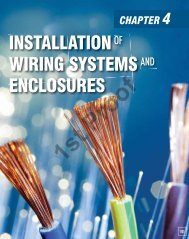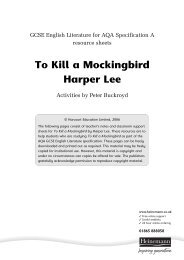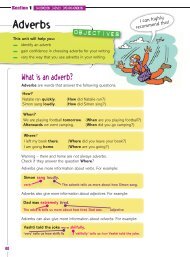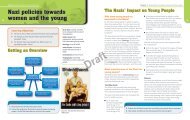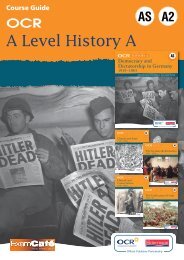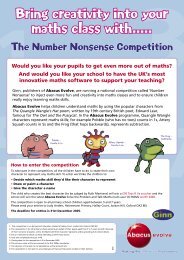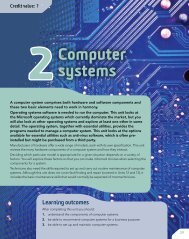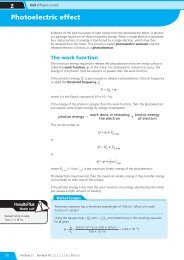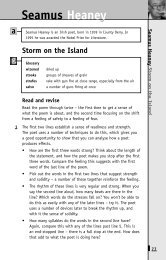Snow White: the Hex Factor - Pearson Schools
Snow White: the Hex Factor - Pearson Schools
Snow White: the Hex Factor - Pearson Schools
Create successful ePaper yourself
Turn your PDF publications into a flip-book with our unique Google optimized e-Paper software.
<strong>Snow</strong> <strong>White</strong>: <strong>the</strong> <strong>Hex</strong> <strong>Factor</strong><br />
Book Band Gold<br />
RR Level 21, 22<br />
Genre Play: Subverted<br />
traditional tale<br />
Length 24 pages (788 words)<br />
Letters and Sounds Phase 6<br />
NC Level 2B<br />
APP Level 2, Secure<br />
Phonics Bug Up to Unit 30<br />
Interest words favourite,<br />
jealous, squabble, announce,<br />
enchanted, accidentally<br />
Summary<br />
The six dwarves are watching <strong>the</strong> ‘The <strong>Hex</strong> <strong>Factor</strong>’ final on TV.<br />
<strong>Snow</strong> <strong>White</strong> and <strong>the</strong> seventh dwarf, Groovy, are singing. When<br />
<strong>the</strong> results are announced, <strong>the</strong> dwarves celebrate <strong>Snow</strong> <strong>White</strong>’s<br />
success, but begin to miss her. However, <strong>the</strong>ir moods soon<br />
change when ano<strong>the</strong>r fairy tale character knocks at <strong>the</strong> door.<br />
Curr. Ref. Objectives<br />
R4<br />
T&L 8<br />
W6<br />
Reading<br />
read, explore, understand<br />
and make use of a range of<br />
traditional and digital texts<br />
Speaking and Listening<br />
express thoughts, feelings<br />
and opinions in response<br />
to … literature … and<br />
activities<br />
Writing<br />
write for a variety of<br />
purposes and audiences<br />
APP Assessment Focus<br />
AF7 (Level 2)<br />
• general features of a few<br />
text types identified<br />
• some awareness that<br />
books are set in different<br />
times and places<br />
AF3 (Level 2)<br />
• extend experience and<br />
ideas, adapting speech,<br />
gesture or movement to<br />
simple roles and different<br />
scenarios<br />
AF6 (Level 2)<br />
• clause structure mostly<br />
grammatically correct<br />
• sentence demarcation<br />
with capital letters<br />
and full stops usually<br />
accurate<br />
PCM
Session 1: Reading & Speaking and Listening<br />
Before Reading<br />
Reading plays<br />
Check that children can recall <strong>the</strong> features of a play and how to<br />
read a play script.<br />
Scene: identify where this play takes place.<br />
Characters: find <strong>the</strong> list of characters and decide who will play<br />
each part. (Note that <strong>the</strong> character with <strong>the</strong> most speeches is at<br />
<strong>the</strong> top of page 2, and <strong>the</strong> o<strong>the</strong>rs are laid out in descending order.)<br />
Lines: discuss which parts are read out loud.<br />
Stage directions: look for examples of instructions in italic<br />
writing and remind children to read <strong>the</strong>se in <strong>the</strong>ir heads.<br />
• Read <strong>the</strong> title and blurb. Talk about children’s expectations<br />
before <strong>the</strong>y read <strong>the</strong> play and explain that, although <strong>the</strong>y<br />
know <strong>the</strong> story of <strong>Snow</strong> <strong>White</strong>, this version is different.<br />
• Ask what ‘The <strong>Hex</strong> <strong>Factor</strong>’ reminds <strong>the</strong>m of. Explain that a<br />
‘<strong>Hex</strong>’ is a type of spell and <strong>the</strong> play is about a talent show on<br />
‘Witch TV’.<br />
• Turn to pages 2–3. Talk about <strong>the</strong> dwarves’ names and what<br />
each name shows about what that character is like.<br />
• Challenge children to look out for o<strong>the</strong>r fairy tale characters as<br />
<strong>the</strong>y are reading.<br />
• Expect children to apply <strong>the</strong>ir phonic knowledge and skills as<br />
<strong>the</strong>y decode words when <strong>the</strong>y are reading <strong>the</strong> play.
During First Reading<br />
• Read <strong>the</strong> play toge<strong>the</strong>r with each child reading <strong>the</strong> line for<br />
<strong>the</strong>ir character out loud when it is <strong>the</strong>ir turn, whilst <strong>the</strong> o<strong>the</strong>rs<br />
follow in <strong>the</strong>ir own books.<br />
Main question: How is this play similar or different to o<strong>the</strong>r<br />
versions of <strong>Snow</strong> <strong>White</strong>? (Reading AF7)<br />
After First Reading (collecting evidence for Reading AF7)<br />
• Ask children whe<strong>the</strong>r anything surprised or puzzled <strong>the</strong>m.<br />
• Support children in making comparisons between <strong>the</strong> play<br />
and o<strong>the</strong>r versions of <strong>Snow</strong> <strong>White</strong>. Ask which characters <strong>the</strong>y<br />
recognised and whe<strong>the</strong>r <strong>the</strong>re were any that were missing.<br />
• Talk about how <strong>the</strong> plot differed from <strong>the</strong> traditional version<br />
and challenge children to refer to <strong>the</strong> play, e.g. on pages<br />
15–16, Soppy turned away <strong>the</strong> witch with <strong>the</strong> poisoned apple.<br />
During Second Reading<br />
• Look back at pages 2–3 and give children different parts to<br />
read. Ask each child to compare <strong>the</strong>ir old and new characters.<br />
• Challenge <strong>the</strong>m to change <strong>the</strong> way <strong>the</strong>y are reading to make<br />
<strong>the</strong>ir new character sound different and to express what that<br />
dwarf is like.<br />
Main question: Which character did you like playing best?<br />
What did you do to change <strong>the</strong> way you read for each<br />
character? (Speaking and Listening AF3)<br />
After Second Reading (collecting evidence for Speaking<br />
and Listening AF3)<br />
• Ask each child to explain which part <strong>the</strong>y preferred.<br />
• Encourage <strong>the</strong> group to give one ano<strong>the</strong>r feedback about <strong>the</strong><br />
most effective reading of each dwarf.
Session 2: Writing<br />
Main focus: Writing a letter from a character, using first person,<br />
complete sentences and past tense. (Writing AF6)<br />
Before Writing<br />
• Ask children to imagine that <strong>the</strong> dwarves are writing letters to<br />
congratulate <strong>Snow</strong> <strong>White</strong> on winning ‘The <strong>Hex</strong> <strong>Factor</strong>’. Talk about<br />
what to include, e.g. what that dwarf was doing during <strong>the</strong> show;<br />
who was at <strong>the</strong> door. Encourage children to refer to <strong>the</strong> play to find<br />
specific details.<br />
• Write each dwarf’s name and note children’s suggestions,<br />
e.g. Dozy: kept falling asleep; Grouchy: moaning, critical.<br />
• Demonstrate how to turn <strong>the</strong> notes into sentences orally, in role as<br />
a dwarf, e.g. I tried to watch <strong>the</strong> final but I kept falling asleep.<br />
During Writing (collecting evidence for Writing AF6)<br />
• Introducing <strong>the</strong> PCM, ask children to choose one dwarf and <strong>the</strong>n<br />
write a letter to <strong>Snow</strong> <strong>White</strong>.<br />
• Encourage children to say <strong>the</strong> whole sentence before writing and to<br />
keep reading through what <strong>the</strong>y have written.<br />
• Check that <strong>the</strong>y are using first person and past tense.<br />
After Writing<br />
• Ask children to give <strong>the</strong>ir letter to ano<strong>the</strong>r child to read.<br />
• Support <strong>the</strong>m as <strong>the</strong>y give each o<strong>the</strong>r feedback. Did it make sense?<br />
Was it written in complete sentences?<br />
Extension: Ideas for Performance<br />
• Children could use small-world play to create <strong>the</strong> dwarves’ house<br />
and dolls for <strong>the</strong> characters.<br />
• They could practise reading <strong>the</strong> play as <strong>the</strong>y move <strong>the</strong> characters,<br />
using expressive voices for <strong>the</strong> dwarves.<br />
• They could also create ‘The <strong>Hex</strong> <strong>Factor</strong>’ stage, judges and performers.<br />
www.pearsonschools.co.uk<br />
myorders@pearson.com<br />
T 0845 630 33 33<br />
F 0845 630 77 77



